It is best to wrap a brisket when the internal temperature has reached 165 – 170 degrees Fahrenheit, but there is lots more to learn!
When I first got to culinary school, I thought that delicate French recipes were going to be tough to master but it is complex meat dishes like brisket that proved to be most challenging!
In this post I am going to show you when to wrap a brisket and also reveal all the other secrets that you need to know to perfect this recipe. Here we go!
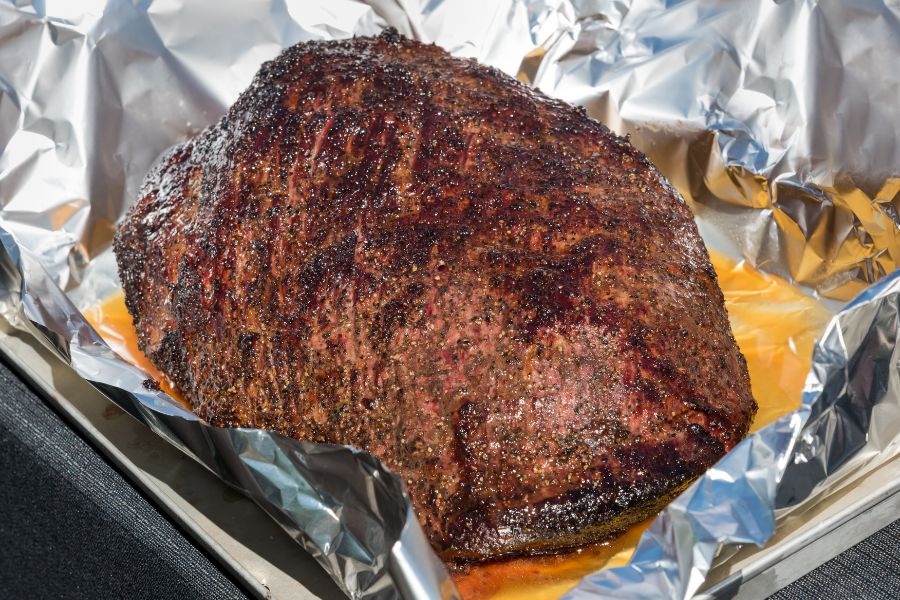
Yes, there is! Pitmasters don’t follow the clock, though, when wrapping brisket. Instead, it is all about internal temperature. When the middle portion of the brisket reaches 165 to 170 degrees, then it is time to get started.
Now, why is this such an important temperature? Well, it is at this point that your brisket begins to stall or when the cooking process appears to stop.
At this temperature, the liquid in your meat begins to evaporate. When this happens, the surface of the meat cools, counteracting the hot air of the smoker. In turn, this prevents the inside of the meat from cooking at the same rate as before.
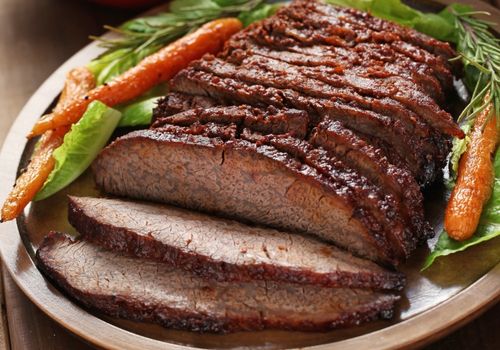
When you wrap the meat, though, you prevent this process from taking place. This speeds up the cooking, allowing your brisket to get done faster.
This is called the Texas Crutch method as many people believe that it originated in Texas. These days, a number of pitmasters on the competition barbecue circuit use this method to keep their meat moist and finish up in time.
Related Reading
If this is the first time that you are wrapping your brisket you are going to want to know the exact moment to wrap the brisket.
Well, there is no way to know for sure until you have read your thermometer. Still, most people agree that you should assign about 30 minutes to an hour of cooking per pound of brisket.
With smaller cuts of meat, I would estimate that the stall will happen about two or three hours into the smoking process. With a larger cut, it may be closer to about three or four hours. Therefore, you can start checking on the temperature at around this point.
If you find that the brisket has reached stall temperature, then you can wrap it. Your other option is to wait for about 20 minutes and to check the temperature of the meat again. If there is no change, then it is time to wrap the brisket.
There are some people who may recommend timing the cooking process and then wrapping brisket between the 3 – 6 hour mark. Going by the cooking time may seem like the easier option, but it isn’t something that I would recommend.
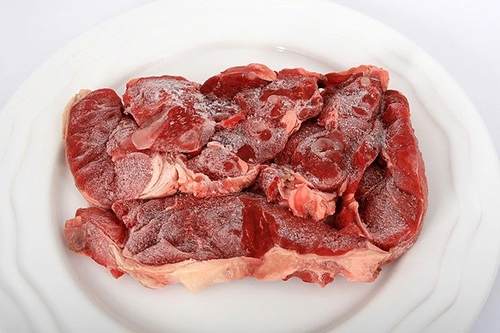
There are a couple of reasons for this. First, cooking time depends on the size of the brisket. A larger piece of meat is going to take longer than a small one. However, it can be really tricky to figure out at which point any cut of brisket will reach its stall.
Furthermore, the smoker temperature will also determine how quickly or slowly your brisket will cook. Due to this, you really don’t want to take the chance that you will get it wrong and ruin all of your hard work.
Go ahead and invest in a meat thermometer and check the meat at regular intervals. It is your best option.
It is possible to wrap a brisket too early. The danger of doing this is that your brisket won’t take on enough smoke. When this happens, your brisket doesn’t develop a proper crunchy bark and you don’t end up with the result that you were hoping for.
Therefore, it is important to be patient, even if your brisket appears to be taking a little longer to cook. Keep track of the internal temperature and only wrap it once it hits the desired range.
This is a pretty common question and if this is something that you are wondering about as well, then yes you can wrap your meat at this temperature. Many pitmasters do this because they find that their meat stall at this point.
If you wrap your brisket at this temperature, then there won’t be a negative impact and you can enjoy a nice, tasty brisket.
Related Reading
As mentioned, the main reason to wrap brisket is for it to cook faster. If you don’t wrap the brisket in time, then the internal temperature of your brisket is going to stay the same for a long time. As such, it is going to take a lot longer to cook your brisket. Needless to say, this isn’t something you want, particularly if you are on a deadline.
The other problem is that the longer that you leave your unwrapped brisket in the smoker, it takes on too much smoke. To a certain point, this can be a good thing as it lends a smoke flavor to the meat. If your smoker is producing dirty smoke, though, then this can cause your brisket to taste bitter.
All in all, keep track of that internal temperature. If it reaches the stall point or you find that the temperature hasn’t climbed in a bit, then it is time to wrap the brisket for a faster cooking time.
You will leave the wrapped brisket as it is until it is finished cooking to the desired temperature. Generally, a brisket is considered ready once the internal temperature has reached 185 to 210 degrees. You should know that a brisket will continue to cook even once it has been removed from the smoker.
What I like to do is to take the meat off the smoker when it hits around 195 degrees. This way, even if the meat cooks a bit more, I don’t have to worry about my meat being overdone and can ensure that the brisket will still have moisture inside.
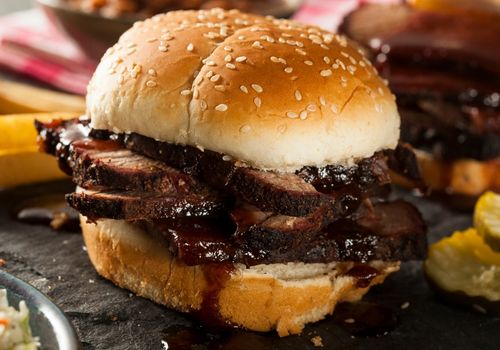
Don’t unwrap the meatevery time that you check the brisket’s temperature. Instead, stick the thermometer through the covering, trying to make as little of a hole as possible.
Related Reading
One of the most important steps in preparing brisket is letting the meat rest. Once you finish cooking the brisket, you need to set it aside for about an hour or two. This allows the flavors and juices to seep throughout the meat.
Skip this step and cut your brisket immediately and you will end up with a dry dish on your hands.
When resting the meat, though, it is important to leave the brisket unwrapped. As mentioned before, meat continues to cook even when it isn’t exposed to heat anymore. Leaving the covering after taking it off the brisket will lead to overcooking.
Related Reading
On a different note, I am also often asked if it is OK to wrap brisket and leave it overnight. With this question, people are talking about wrapping brisket before the cooking process, but once the rub has been applied to the meat.
In this case, I would advise wrapping your brisket and leaving it overnight in the fridge. This allows the flavors of the rub to really penetrate the meat, resulting in a better flavor.
Unlike when cooking brisket, though, you will need to use a different covering. I would suggest using plastic or clingwrap for this purpose. Just make sure to unwrap it carefully so that none of the rub is lifted off with the plastic.
Before you can learn how to wrap brisket, you need to know what you should be using for the covering. The top two choices here are aluminum foil and butcher paper.
Now, for the longest time, aluminum foil was the way to go. In fact, the original Texas Crutch method relied on this material. More recently, though, pink butcher paper also known as peach paper has becoming increasingly popular. So, aluminum foil or butcher paper – what should you use?
What most pitmasters like about aluminum foil is that it results in a faster cooking time. This is because with the brisket in foil, no moisture can escape. This results in a tender and juicier meat.
The only downside is that aluminum foil lacks breathability. If you aren’t careful, too much moisture can get trapped inside, resulting in a softer bark.
With butcher paper, the paper is more porous. This allows the steam to escape a little, creating a good bark, while still maintaining moisture. You do have to be careful that your brisket doesn’t dry out too much when using butcher paper, though. Also, your brisket will not cook nearly as quickly.
At the end of the day, though, it is all about personal preference. Although I used to primarily rely on aluminum foil, for instance, I know will utilize butcher paper just as often. It is all about what you feel comfortable with.
Related Reading
As with anything, you will find cheaper and more premium versions of aluminum foil and butcher paper. Do yourself a favor and splurge on the high quality options. This will result in less fuss for you.
When it comes to foil – heavy duty aluminum foil is your best option. There is less likely to be any tearing. As for butcher paper, look for unwaxed and untreated paper for the best results.
Here is what you need to know about wrapping brisket:
You will need two wide sheets of either aluminum foil or pink butcher paper. They will each need to be around four times as long as the width of the beef brisket.
Place the aluminum foil or butcher paper on a flat surface. The longest side should be perpendicular to you. Then, place the second sheet of foil or butcher paper on top – about half the width should overlap here.
Next, place the brisket in butcher paper or aluminum foil, about one foot away from the bottom edge. Fold this edge over the brisket, stretching it as tightly as you can – make sure not to tear the material, though. When you are done, you should be able to see the outline of the edges of the brisket.
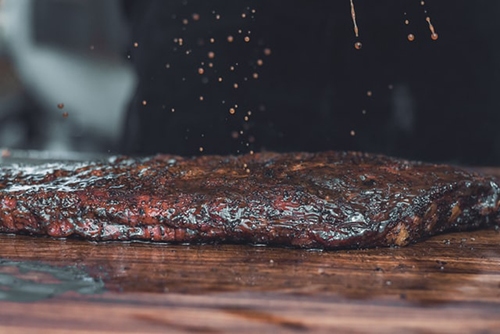
Then take the side of the paper or foil and fold it over the brisket but at an obtuse angle. As before, the bottom of the paper should conform to the shape of the brisket. Repeat this step with the other side of the paper or the foil.
After this, you should take the entire wrapped brisket and roll it over so that it is covered by an additional layer of foil or butcher paper. Then, fold in each side once more.
You will now have some leftover butcher paper or foil at the top. Fold these so that the paper doubles in thickness. After this, roll the brisket over one last time. Make sure everything is tight and you will have finishing wrapping brisket!
I would suggest trying this technique out with a box or something else first. This will allow you to get a handle on how to do it and prevent tearing at the same time. What’s more, once your brisket is ready to be wrapped, you will be able to tackle it quickly and efficiently.
Related Reading
Now that you know all that you should about wrapping brisket, lets tackle one final question – is it worth the effort? Should you bother with this process or put your meat in the smoker unwrapped?
I would be the first one to say that the decision is yours. It is all about what you find easiest to do as well as what kind of flavor and result you are looking for when smoking brisket.
There are plenty of advantages of wrapping your brisket. These have already been outlined – greater tenderness, the right amount of smoke flavor, and greater control over the bark. This isn’t necessarily the best option for everyone, though.
For instance, I know a lot of pitmasters who are all about that darker bark. They want a super crunchy bark that they can really bite into. Needless to say, you can’t exactly get this effect with the Texas Crutch since there is too much moisture in the works.
Thus, if this is your goal, then I would advise you to cook unwrapped. You do have to understand what will happen if you do this, however and take the necessary precautions to avoid any missteps.
If you are planning on smoking brisket unwrapped, then its a good idea to buy brisket that has a bit more marbling on it. When fat melts, it adds moisture to the surrounding meat, allowing the brisket to maintain its juiciness. It is great for flavor as well!
First of all, you have to appreciate that your brisket is going to take a lot longer to cook. If you have a deadline such as a dinner or a party, then I would plan accordingly. Start cooking the brisket several hours earlier than intended.
Personally, I would tell you to wrap the brisket for a little while, at least until the internal temp has gone up a little. Otherwise, waiting for your brisket to cook can be a frustrating and time consuming process.
The other thing that you have to watch out for is your brisket drying out. In fact, I would say that this is the biggest issue that you might face with this smoked meat.
One way to cut down on this risk and ensure juicier meat is to apply a dry salt rub to the brisket, wrap it, and then leave it overnight in the fridge. Some people will also inject briny water and marinade directly into the meat, but this can be tricky to get right. You can also mess with the natural flavors and juices of the brisket.
You can also choose to baste the brisket every so often. You can spritz the brisket with apple juice, apple cider vinegar, or broth every hour or so. If you don’t want to change the flavor, though, you can use plain water as well.
Well, this is what you should know about the Texas Crutch. From when to how, your can find all the answers to your questions right here. The only thing that is left for you to do is to put this information to good use.
Go ahead and get that Texas barbecue going now! Your brisket may not turn out perfect the first time around but with the tips and tricks above, you will be able to get pretty close!